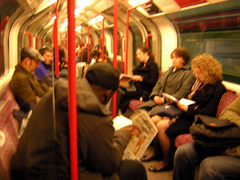


Where is it?
It’s comfortably straddled between Victoria Park and the Olympic Park, but in spite of this it’s still a bit of a no man’s land. However now that Shoreditch is the new West End, the wheels of gentrification are dribbling forward. Hackney Wick (dubbed Hackney Candle by some because candles burn out) suffers the misfortune of having several arterial roads crossing it, cutting it off from the rest of civilisation. This coupled with flyovers and empty industrial sites make for some pretty hostile scenery in places – some locals avoid hanging around the areas surrounding Hackney Wick station after dark. In terms of transport it’s improving, thanks to the newly invigorated London Overground (once the exasperating Silverlink), connecting Stratford to Richmond via Willesden Junction.
Tell me more
It was vastly rural here until the 18th century, but the name “Wick” comes from “Wyk”, the old term for a dairy farm; there was one here in the 1200s. The earliest known business was a porcelain factory founded in the 1740s, one of the first in Britain. The River Lea was proving very handy for transporting goods, and this was one of the reasons why the area became an important industrial suburb in the 19th century. Chemical and confectionery were the two main areas of manufacture, but Hackney Wick’s greatest claims to fame may be that both toilet paper and plastic were made here for the first time, and that the word for “petrol” was coined at petrochemical company Carless, Capel & Leonard.
With the surge in employment came overcrowding and slums. Heavy bombing during WWII destroyed many houses, and the local industry was affected too, with companies having to close imminently or suffering such damage to their buildings they ended up having to close in subsequent years. Very few pre-war buildings still stand today.
In the 1970s light industries like printing companies arrived, attracted by cheap rent, but they have since had to move out to accommodate the Olympic Games, which were being touted as the saviour of E9. Local residents became more and more dubious as they noticed small businesses, independent pubs and even allotments be swiftly moved on to make way for new developments.
Is it going to become insufferably fashionable?
In a nutshell, yes. As with its predecessor Shoreditch and many others before that, the low cost of living attracted plenty of artists in 90s - in fact there are supposedly more artists here per capita than anywhere else in the world. There are also over 600 artist workspaces, which considering there are only 2100 people living here is pretty impressive. Two of these are owned by enfant terribles Jake and Dinos Chapman, and Gavin Turk. Now hip cafes and bars are starting to open, so inevitably there is going to be more disposable wealth in the area.
\n\nSo there’s loads going then?
Hackney Marshes and the Lea Valley are the reason why many use the oft-quoted “it doesn’t feel like London”. But while there are plenty of tranquil green bits, it’s not that quiet at all.
This is still one of London’s most deprived areas, but there is a thriving cultural scene, albeit a segregated one (ask elderly residents whether they’re aware of the statistics mentioned above and it’s likely they’ll look at you as if you’d just swung a cat by its tail). The annual three-day arts festival Hackney WickED launched in 2008 promotes local artists; it takes place in August and encompasses exhibitions, workshops and live music at several venues. The area’s many disused warehouses are ideal for hosting club nights, as the majority are not located near residential properties and so there is no risk of keeping anyone awake at night; see Autumn Street Studio and Mother Studios. Cafes like Counter Café on Roach Road, nestled within the Stour Space gallery, and restaurants like the Hackney Pearl are also raising the Wick’s profile considerably. Crate Brewery offers on-trend pizzas and craft beers, and H. Forman & Son, a family-owned smoker’s dating back to 1905, opened “the closest venue to the 2012 Olympic Stadium”, complete with restaurant/smokery/gallery/corporate event space. A hefty sum was paid to ensure Forman’s Fish Island would be ready to accommodate visitors to the Games, but as it turned out a lot of them stayed at home.
The choice of shops is still abysmal - researchers have found that the average distance from home to a supermarket or post office is at least three times that of any other part of London. Then again, the lovely, hyperlocal Westfield Stratford is just one stop away.
The transformation of Hackney Wick certainly accelerated in the run-up to the Games. Promises were made that they would breathe new life into the area, but the first, most obvious impact has been hikes in property prices. Which neatly brings us to…
\n\nYou’re going to tell me I can’t afford it here either, aren’t you?
Um yeah, sort of. All this talk of unconventional living/commercial opportunities makes estate agents’ ears prick up. It does depend where you look however; the attractive, large bay-fronted houses on Cadogan Terrace that overlook Victoria Park are expensive, but move away from the park and closer to the more industrial parts and things get cheaper, particularly the purpose-built housing built after World War II. Students, arty people and young professionals tend to occupy shared converted warehouses, while young middle class families are buying up the aforementioned three-bed Victorian terraces.
Sounds like a great mix of bohemia and edginess.
Except it’s a bit more divisive than that. The artistic community is concentrated in the southern part of Hackney Wick, while other residents are in the north. Furthermore, a 2012 study by the London School of Economics (Stitch the Wick) mentions that 5% of homes in the area lack central heating, yet there are some semi-plush looking new apartment blocks on Vantage Square that won’t have to put up with headaches like these.


